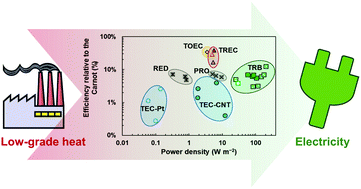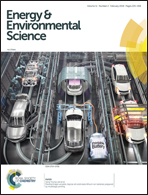Emerging electrochemical and membrane-based systems to convert low-grade heat to electricity
Abstract
Low-grade heat from geothermal sources and industrial plants is a significant source of sustainable power that has great potential to be converted to electricity. The two main approaches that have been extensively investigated for converting low-grade heat to electrical energy, organic Rankine cycles and solid-state thermoelectrics, have not produced high power densities or been cost-effective for such applications. Newer, alternative liquid-based technologies are being developed that can be categorized by how the heat is used. Thermoelectrochemical cells (TECs), thermo-osmotic energy conversion (TOEC) systems, and thermally regenerative electrochemical cycles (TRECs) all use low-grade heat directly in a device that generates electricity. Other systems use heat sources to prepare solutions that are used in separate devices to produce electrical power. For example, low-temperature distillation methods can be used to produce solutions with large salinity differences to generate power using membrane-based systems, such as pressure-retarded osmosis (PRO) or reverse electrodialysis (RED); or highly concentrated ammonia solutions can be prepared for use in thermally regenerative batteries (TRBs). Among all these technologies, TRECs, TOEC, and TRBs show the most promise for effectively converting low-grade heat into electrical power mainly due to their high power productions and energy conversion efficiencies.



 Please wait while we load your content...
Please wait while we load your content...